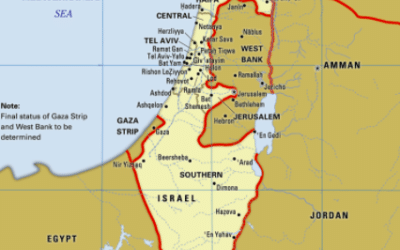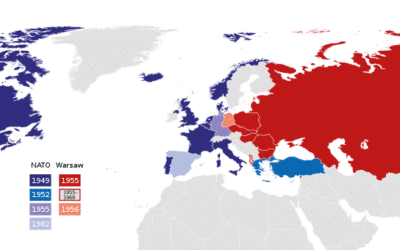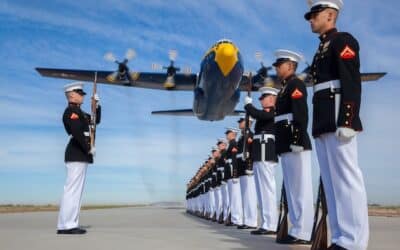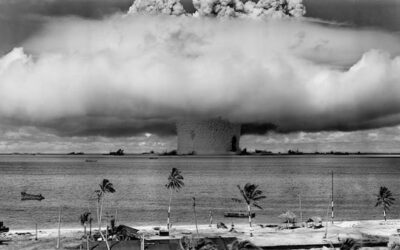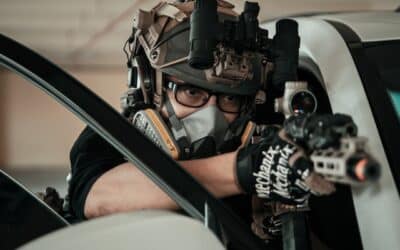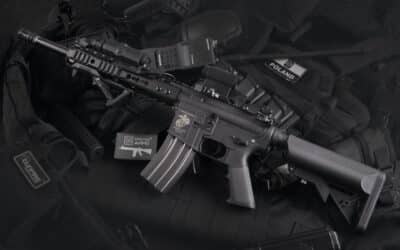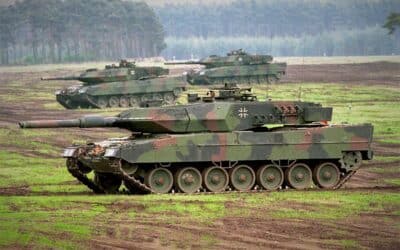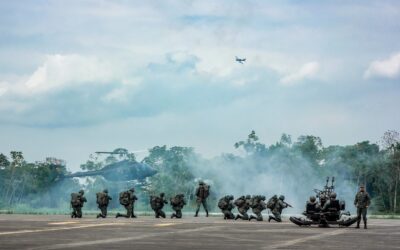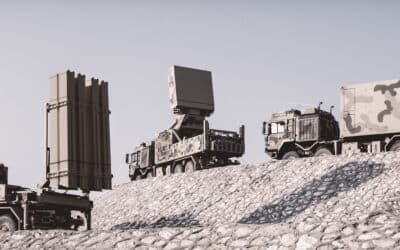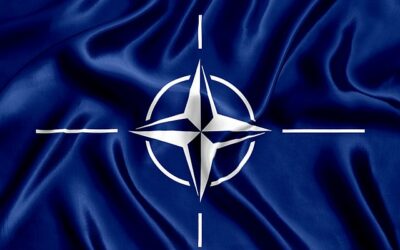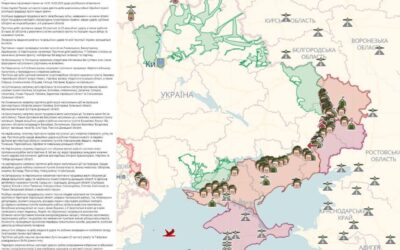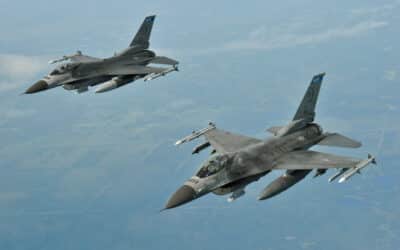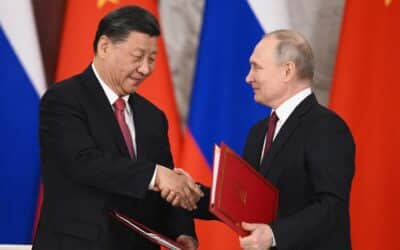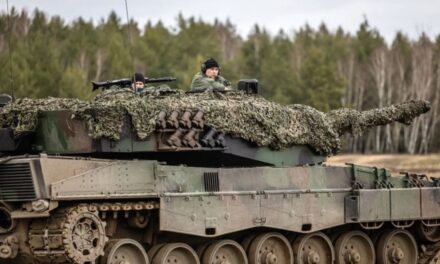Image: Wikipedia
Fighter jets are a testament to human ingenuity and power. These ten jets reign supreme when it comes to supremacy in the skies. They’re not just fast; they’re the fastest. They’re not just powerful; they’re the most powerful. This list of the ten strongest fighter jets in the world will reveal which aircraft are at the pinnacle of aerial combat. These mechanical marvels have the latest technology, unparalleled speed, and devastating firepower. Whether for defense or attack, these jets are the ultimate tools of aerial warfare.
In aviation, these top ten fighter jets have proven their worth in combat and peacekeeping missions. These aircraft are revered and respected from the United States to Russia, Europe to Asia. Get ready to learn about the most formidable flying machines ever taken to the skies.
What Makes a Fighter Jet Powerful?
Introduction
Fighter jets are not only impressive feats of engineering but also powerful machines that play a critical role in modern military operations. These high-performance aircraft are designed to dominate the skies, showcasing remarkable speed, agility, and firepower. This section will explore the key factors that make a fighter jet powerful, delving into its advanced technologies, aerodynamic designs, and lethal weaponry.
Advanced Technologies
One of the primary factors contributing to a fighter jet’s power is the advanced technologies it incorporates. These cutting-edge systems enhance the aircraft’s capabilities, allowing it to outperform its adversaries. From state-of-the-art avionics to sophisticated radar systems, fighter jets are equipped with various advanced technologies that provide pilots with critical information, improve situational awareness, and enable precise targeting. These technologies also facilitate seamless communication and coordination during complex missions, enhancing the overall effectiveness of the aircraft.
Aerodynamic Design
The aerodynamic design of a fighter jet is another crucial aspect that makes it powerful. These aircraft are meticulously crafted to minimize drag, maximize maneuverability, and achieve exceptional speed. The sleek and streamlined shapes of fighter jets, coupled with their carefully designed wings and control surfaces, enable them to swiftly cut through the air while maintaining stability. This aerodynamic superiority allows fighter jets to achieve incredible speeds and execute complex aerial maneuvers precisely, giving them a significant advantage in combat situations.
Engine Power
Fighter jets are propelled by immensely powerful engines that generate thrust to push the aircraft forward. The engines used in these aircraft are specifically designed to deliver exceptional power-to-weight ratios, allowing them to accelerate rapidly and achieve supersonic speeds. The ability to swiftly accelerate and maintain high rates is vital for fighter jets, enabling them to engage and disengage from combat swiftly, evade enemy fire, and respond speedily to changing battlefield conditions. The immense engine power of fighter jets ensures that they are always at the forefront of aerial dominance.
Firepower and Weapon Systems
A fighter jet’s firepower and weapon systems are integral to its power on the battlefield. These aircraft are equipped with a wide range of lethal weapons, including missiles, bombs, and cannons, enabling them to effectively engage and neutralize enemy targets. The advanced targeting systems and precision-guided munitions allow fighter jets to strike with utmost accuracy and devastating impact. Some fighter jets are also equipped with advanced electronic warfare systems that can disrupt enemy communications and defenses, further enhancing their combat effectiveness.
Conclusion
In conclusion, fighter jets possess many factors contributing to their immense power. Advanced technologies, aerodynamic designs, powerful engines, and lethal weaponry all make these aircraft formidable on the battlefield. The advancements in aviation technology ensure that fighter jets will continue to evolve, pushing the boundaries of what is possible and maintaining their status as the epitome of aerial power.
F-22 Raptor

Image: https://www.military.com/
The F-22 Raptor is an exceptional fighter jet known for its superior capabilities and advanced technology. Since its introduction in 2005, the F-22 Raptor has been a game-changer in aviation. In this section, we will delve into the overview, key features, and capabilities, as well as the performance and combat effectiveness of the F-22 Raptor.
Overview of the F-22 Raptor
The F-22 Raptor, developed by Lockheed Martin, is a fifth-generation, single-seat, twin-engine fighter aircraft. It was designed primarily for air superiority missions and possesses ground attack, electronic warfare, and signal intelligence capabilities. With its sleek and stealthy design, the F-22 Raptor is virtually undetectable by enemy radar systems, giving it a massive advantage in combat situations.
Key Features and Capabilities of the F-22 Raptor
1. Stealth Technology: The F-22 Raptor’s stealth capabilities are unparalleled. Its unique shape, radar-absorbent materials, and advanced coatings allow the aircraft to evade detection and avoid enemy engagement.
2. Supercruise: The F-22 Raptor can fly at supersonic speeds without afterburners. This gives it a significant advantage in fuel efficiency and extended range.
3. Advanced Avionics: Equipped with state-of-the-art avionics, the F-22 Raptor provides pilots with enhanced situational awareness, enabling them to make split-second decisions during high-pressure combat scenarios.
4. Superior Maneuverability: The F-22 Raptor’s innovative thrust vectoring system allows it to perform incredibly agile maneuvers, making it highly effective in air-to-air and air-to-ground combat.
5. Sensor Fusion: The F-22 Raptor integrates data from various sensors, such as radar, infrared, and electronic warfare systems, to provide a comprehensive and real-time picture of the battlefield.
Performance and Combat Effectiveness of the F-22 Raptor
The F-22 Raptor’s performance capabilities are truly remarkable. It can achieve a top speed of Mach 2.25 (approximately 1,500 mph) and has a maximum range of over 1,800 nautical miles. Its service ceiling extends to an astonishing 65,000 feet, allowing it to easily dominate the airspace.
When it comes to combat effectiveness, the F-22 Raptor shines. Its advanced stealth technology and superior maneuverability enable it to conduct precision strikes on enemy targets while remaining virtually invisible. Integrating advanced avionics and sensor fusion systems further enhances its combat capabilities, providing pilots with unmatched situational awareness and target engagement capabilities.
Moreover, the F-22 Raptor is equipped with advanced weaponry, including air-to-air and air-to-ground missiles, ensuring its ability to neutralize any threat.
In conclusion, the F-22 Raptor represents the pinnacle of modern fighter jet technology. Its stealth, speed, maneuverability, and advanced capabilities make it a force to be reckoned with in the skies. Whether dominating the air-to-air battlefield or executing precision strikes on ground targets, the F-22 Raptor is unparalleled in its combat effectiveness.
Sukhoi Su-57
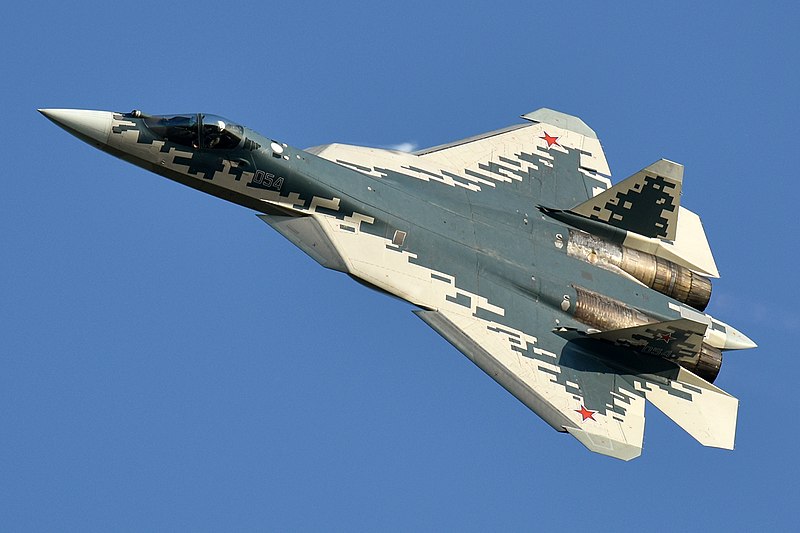
Image: https://en.wikipedia.org/
Overview of the Sukhoi Su-57
The Sukhoi Su-57, also known as the PAK FA (Perspective Aviation Complex of Frontline Aviation), is a fifth-generation multi-role fighter aircraft developed by Russia. This advanced fighter jet is designed to excel in air superiority missions and perform various tactical operations. With its sleek and aerodynamic design, the Su-57 delivers superior performance and exhibits remarkable stealth capabilities.
Key Features and Capabilities of the Sukhoi Su-57
Stealth Technology: Concealed in Shadows
The Su-57 incorporates advanced stealth technology, virtually invisible to enemy radar systems. Its carefully designed composition, combined with radar-absorbing materials and special coatings, minimizes its radar cross-section. This enables the Su-57 to operate undetected, providing a significant advantage in combat situations.
Superior Maneuverability: Dominating the Skies
Equipped with powerful engines and thrust-vectoring nozzles, the Su-57 possesses exceptional maneuverability. This allows it to perform complex aerial maneuvers, including high angles of attack and tight turns, giving it a considerable edge in dogfights. The combination of its agility and advanced avionics systems makes the Su-57 a formidable adversary in the air.
Next-Generation Avionics: The Power of Precision
The Su-57 is equipped with state-of-the-art avionics that enhance its combat capabilities. Its advanced radar system provides excellent target acquisition, tracking, and long-range detection capabilities. Additionally, the Su-57 features an advanced sensor fusion system, enabling real-time data integration from various sources to provide pilots with a comprehensive situational awareness, empowering them to make informed decisions swiftly.
Supersonic Speeds: Swift and Deadly
Capable of reaching speeds exceeding Mach 2, the Su-57 excels in speed and acceleration. Its powerful engines enable rapid acceleration, allowing it to swiftly engage and disengage from combat situations. With its speed advantage, the Su-57 can evade enemy threats and close in on targets with remarkable speed, delivering devastating firepower when necessary.
Performance and Combat Effectiveness of the Sukhoi Su-57
The Su-57’s cutting-edge features and capabilities translate into exceptional performance and combat effectiveness. Its stealth technology and superior maneuverability enable it to engage enemies on its own terms, striking with precision while remaining undetected. With its advanced avionics and sensor fusion system, the Su-57 provides pilots unparalleled situational awareness, giving them a significant advantage in complex operational environments.
The Su-57’s speed and acceleration further enhance its combat effectiveness, allowing it to swiftly respond to evolving threats and engage targets effectively. Its integration with other combat platforms makes it a valuable asset in joint operations. Whether engaging in air-to-air combat or delivering precision strikes against ground targets, the Su-57 is a true force multiplier in modern warfare.
In conclusion, the Sukhoi Su-57 represents the pinnacle of technological advancements in fighter jet design. With its stealth capabilities, superior maneuverability, advanced avionics, and exceptional performance, the Su-57 sets new standards for combat aircraft. As we continue to witness the evolution of military aviation, the Su-57 stands as a testament to human ingenuity and engineering prowess.
Chengdu J-20

Image: https://en.wikipedia.org/
The Chengdu J-20 is regarded as one of the world’s most advanced and formidable fighter jets. Its sleek design and cutting-edge technology make it a force to be reckoned with in modern aerial warfare. In this section, we will delve into the overview, key features, and capabilities, as well as the performance and combat effectiveness of the Chengdu J-20.
Overview of the Chengdu J-20
The Chengdu J-20, also known as the Mighty Dragon, is a fifth-generation stealth fighter aircraft developed by China. It made its first public appearance in 2011, marking a significant milestone in China’s aviation industry. With its distinctive delta wing configuration and stealthy features, the J-20 is designed to excel in air superiority missions and long-range strikes.
Key Features and Capabilities of the Chengdu J-20
The Chengdu J-20 boasts an array of impressive features and capabilities that set it apart from its counterparts. Here are some key highlights:
- Stealth Technology: The J-20’s stealth capabilities enable it to avoid detection by radar systems, granting it the element of surprise in combat situations.
- Advanced Avionics: Equipped with state-of-the-art avionics systems, the J-20 provides its pilots with unparalleled situational awareness and enhanced combat effectiveness.
- Supercruise Capability: The J-20’s powerful engines can achieve supersonic speeds without relying on afterburners, ensuring greater fuel efficiency and extended operational range.
- Long-Range Intercept: With its long-range detection and engagement capabilities, the J-20 can effectively intercept and neutralize threats before they pose a danger.
- Air-to-Air and Air-to-Ground Capabilities: The J-20 is equipped with advanced radar and weapon systems, enabling it to engage both aerial and ground targets with precision and versatility.
Performance and Combat Effectiveness of the Chengdu J-20
Regarding performance, the Chengdu J-20 is a force to be reckoned with. Its high maneuverability, combined with its advanced aerodynamics, allows it to outmaneuver adversaries with ease. The J-20’s ability to supercruise gives it a tactical advantage, enabling it to respond quickly to evolving combat situations.
Furthermore, the J-20’s combat effectiveness is enhanced by its advanced weaponry and avionics systems. Its long-range air-to-air missiles and precision-guided munitions ensure that it can engage and neutralize threats from a safe distance. The J-20’s stealth capabilities also play a vital role in combat effectiveness, as it can enter enemy airspace undetected, carrying out devastating surprise attacks.
In conclusion, the Chengdu J-20 is a game-changing fighter jet that embodies the pinnacle of Chinese aviation technology. Its stealth features, advanced capabilities, and exceptional performance pose a significant challenge to its adversaries. As the J-20 continues to evolve and be integrated into China’s air force, it will undoubtedly shape the future of aerial warfare.
Eurofighter Typhoon
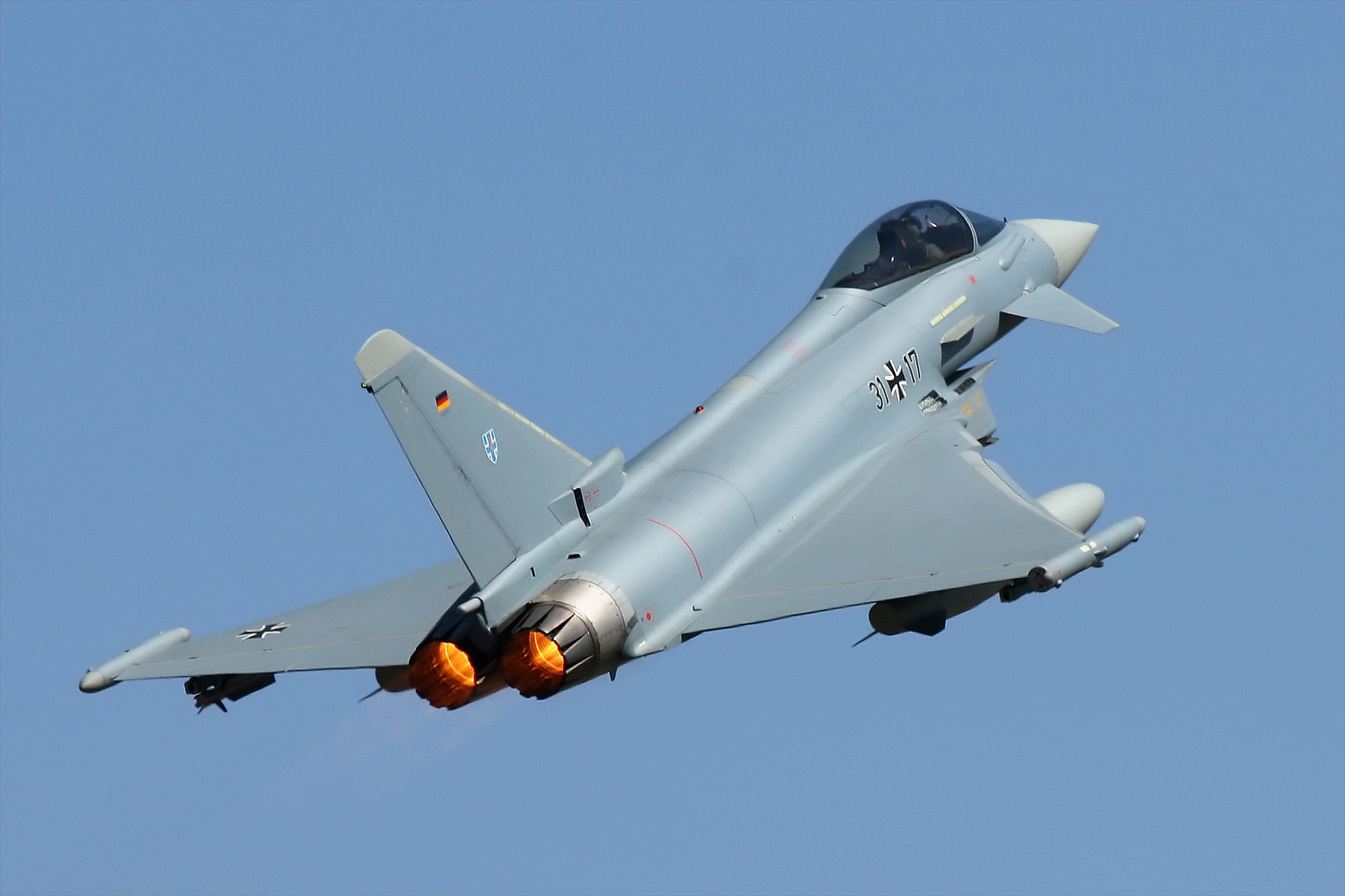
Image: https://en.wikipedia.org/
The Eurofighter Typhoon is one of the most advanced fighter jets in the world, known for its exceptional performance and cutting-edge capabilities. In this section, we will delve into an overview of the Eurofighter Typhoon, highlighting its key features and capabilities, as well as its impressive performance and combat effectiveness.
Overview of the Eurofighter Typhoon
The Eurofighter Typhoon, developed by a consortium of European aerospace companies, is a multi-role fighter aircraft designed to excel in air-to-air and air-to-ground missions. With its sleek aerodynamic design and advanced technology, the Eurofighter Typhoon boasts superior maneuverability and versatility.
Featuring a twin-engine configuration, the Eurofighter Typhoon can reach impressive speeds, allowing it to rapidly respond to threats in various operational scenarios. Its sleek design minimizes drag and enhances its overall performance, making it a force to be reckoned with in the skies.
Key Features and Capabilities of the Eurofighter Typhoon
The Eurofighter Typhoon has a wide array of state-of-the-art features and capabilities, contributing to its unrivaled performance. Here are some key highlights:
- Advanced Avionics: The Eurofighter Typhoon incorporates cutting-edge avionics systems, including a sophisticated radar system and a powerful mission computer. These advanced systems enable the pilot to simultaneously acquire and track multiple targets, providing a significant tactical advantage.
- Superior Maneuverability: The Eurofighter Typhoon offers exceptional maneuverability with its advanced fly-by-wire flight control system. It’s precise control response and high agility allow the pilot to outmaneuver adversaries in air combat situations.
- Weapons Systems: The Eurofighter Typhoon has many weapon systems, including air-to-air missiles, air-to-surface missiles, and guided bombs. This extensive arsenal enables the aircraft to effectively engage targets in air-to-air and air-to-ground missions.
- Stealth Technology: The Eurofighter Typhoon incorporates stealth technology to reduce its radar cross-section, making it less detectable to enemy radar systems. This feature enhances the aircraft’s survivability and increases its chances of successful mission completion.
Performance and Combat Effectiveness of the Eurofighter Typhoon
When it comes to performance, the Eurofighter Typhoon sets the bar high. Its impressive capabilities allow it to excel in various combat scenarios. Here are some critical aspects of its performance and combat effectiveness:
- Speed and Altitude: The Eurofighter Typhoon can reach a top speed of Mach 2, enabling it to rapidly engage targets at long distances. Its high-altitude performance allows it to operate effectively in different environments.
- Advanced Sensors: The Eurofighter Typhoon’s advanced sensors provide the pilot with real-time situational awareness, enhancing their ability to detect and engage threats effectively. These sensors and their powerful radar system enable the aircraft to operate in challenging conditions.
- Air Superiority: With its exceptional maneuverability and advanced weapon systems, the Eurofighter Typhoon is a formidable force in air-to-air combat. Its ability to engage multiple targets simultaneously ensures air superiority in complex operational scenarios.
- Precision Strike: In air-to-ground missions, the Eurofighter Typhoon’s precision strike capabilities come into play. Its advanced targeting systems and guided weapons allow for accurate and efficient engagement of ground targets, minimizing collateral damage.
In conclusion, the Eurofighter Typhoon is a highly advanced and capable fighter jet. Its impressive features, superior performance, and combat effectiveness make it a force to be reckoned with in the skies. Whether engaging in air-to-air combat or precise air-to-ground missions, the Eurofighter Typhoon proves its mettle, ensuring dominance in the modern battlefield.
Lockheed Martin F-35 Lightning II

Image: https://en.wikipedia.org/
The Lockheed Martin F-35 Lightning II is a cutting-edge fifth-generation multi-role fighter jet that has revolutionized the world of military aviation. With its advanced technology and exceptional capabilities, the F-35 stands out as one of the most formidable fighter jets in the world.
Overview of the Lockheed Martin F-35 Lightning II
The F-35 Lightning II, developed by Lockheed Martin, is a single-seat, single-engine aircraft that serves the United States Air Force, Navy, Marine Corps, and numerous international partners. It is designed to excel in air-to-air and air-to-ground missions, providing unmatched versatility on the battlefield.
Key Features and Capabilities of the Lockheed Martin F-35 Lightning II
The F-35 Lightning II boasts several key features and capabilities that set it apart from other fighter jets. Here are some of its standout attributes:
- Stealth Technology: The F-35 incorporates advanced stealth technology, making it virtually undetectable by enemy radar systems. Its low observable design allows it to penetrate hostile airspace with reduced vulnerability.
- Advanced Avionics: Equipped with state-of-the-art avionics systems, the F-35 provides its pilots unparalleled situational awareness. Its integrated sensor fusion enables real-time data sharing and enhances decision-making capabilities.
- Supersonic Speed: The F-35 Lightning II can reach a top speed of Mach 1.6, allowing it to rapidly close in on targets or evade incoming threats. Its powerful engine provides impressive acceleration, ensuring quick response times.
- Vertical Takeoff and Landing (VTOL) Capabilities: One variant of the F-35, the F-35B, is capable of short takeoff and vertical landing, making it ideal for operations in confined areas or on aircraft carriers. This feature dramatically enhances its operational flexibility.
- Advanced Weapon Systems: The F-35 has a wide range of air-to-air and air-to-ground weapon systems, enabling it to engage various targets with precision and devastating effect. Its internal weapons bays help maintain its stealth capabilities while carrying a significant payload.
Performance and Combat Effectiveness of the Lockheed Martin F-35 Lightning II
In terms of performance, the F-35 Lightning II surpasses many of its predecessors. Its advanced aerodynamics, and powerful engine allow it to maneuver swiftly and effectively in aerial dogfights and ground attack missions. Additionally, its advanced sensors and avionics systems enable it to gather and process vast amounts of data, providing pilots a tactical edge on the battlefield.
The combat effectiveness of the F-35 has been demonstrated through its successful deployment in various real-world scenarios. Its integration with other military assets, such as ground forces or naval vessels, enhances joint operational capabilities. The F-35’s versatility allows it to adapt to changing mission requirements, making it a potent force multiplier.
The Lockheed Martin F-35 Lightning II represents a significant leap forward in fighter jet technology. Its stealth, advanced avionics, speed, and firepower make it a formidable asset in modern warfare. As the F-35 continues to evolve and new capabilities are added, it solidifies its position as one of the strongest fighter jets in the world.
Dassault Rafale

Image: https://en.wikipedia.org/
Overview of the Dassault Rafale
Regarding modern fighter jets, the Dassault Rafale is undoubtedly a force to be reckoned with. Developed by the esteemed French aerospace company Dassault Aviation, the Rafale has gained a reputation for its exceptional versatility, advanced technology, and impressive combat capabilities. This multi-role fighter aircraft is designed to excel in various missions, from air superiority and ground attacks to reconnaissance and nuclear deterrence.
Key Features and Capabilities of the Dassault Rafale
The Dassault Rafale boasts an array of cutting-edge features and capabilities that set it apart from its counterparts. One of its key strengths lies in its design, which combines agility, aerodynamics, and stealth characteristics. This enables the Rafale to maneuver swiftly through the skies while remaining undetectable to enemy radars.
Equipped with state-of-the-art avionics and advanced sensor systems, the Rafale ensures superior situational awareness for its pilots. Its integrated systems provide real-time data, allowing for quick decision-making and precise execution of missions. The Rafale’s advanced electronic warfare capabilities also make it highly adept at countering enemy threats, including air defense systems.
Furthermore, the Rafale’s impressive arsenal of weaponry is a testament to its combat prowess. It can carry various air-to-air and air-to-ground missiles, precision-guided bombs, and nuclear weapons. This versatility allows the Rafale to adapt to multiple mission objectives, providing flexibility on the battlefield.
Performance and Combat Effectiveness of the Dassault Rafale
In terms of performance, the Dassault Rafale truly shines. Powered by two efficient and reliable engines, it achieves remarkable speed and maneuverability, enabling it to outperform many adversaries. Its ability to supercruise, or sustain supersonic speeds without afterburners, grants the Rafale a significant tactical advantage.
The Rafale’s combat effectiveness is evident in its track record. It has demonstrated its capabilities in numerous conflicts and military operations, showcasing its reliability and success on the battlefield. The Rafale has consistently delivered outstanding results, from air superiority missions to precision strikes against high-value targets.
Moreover, the Rafale’s combat effectiveness is enhanced by its ability to seamlessly integrate with other elements of a modern air force. Its compatibility with allied aircraft, naval vessels, and ground forces ensures effective joint operations, maximizing overall mission success.
In conclusion, the Dassault Rafale is a testament to the ingenuity and engineering prowess of Dassault Aviation. Its versatility, advanced features, and remarkable combat effectiveness make it one of the strongest fighter jets in the world. The Rafale delivers unparalleled performance, whether dominating the skies, striking with precision, or ensuring national security.
Mikoyan MiG-35
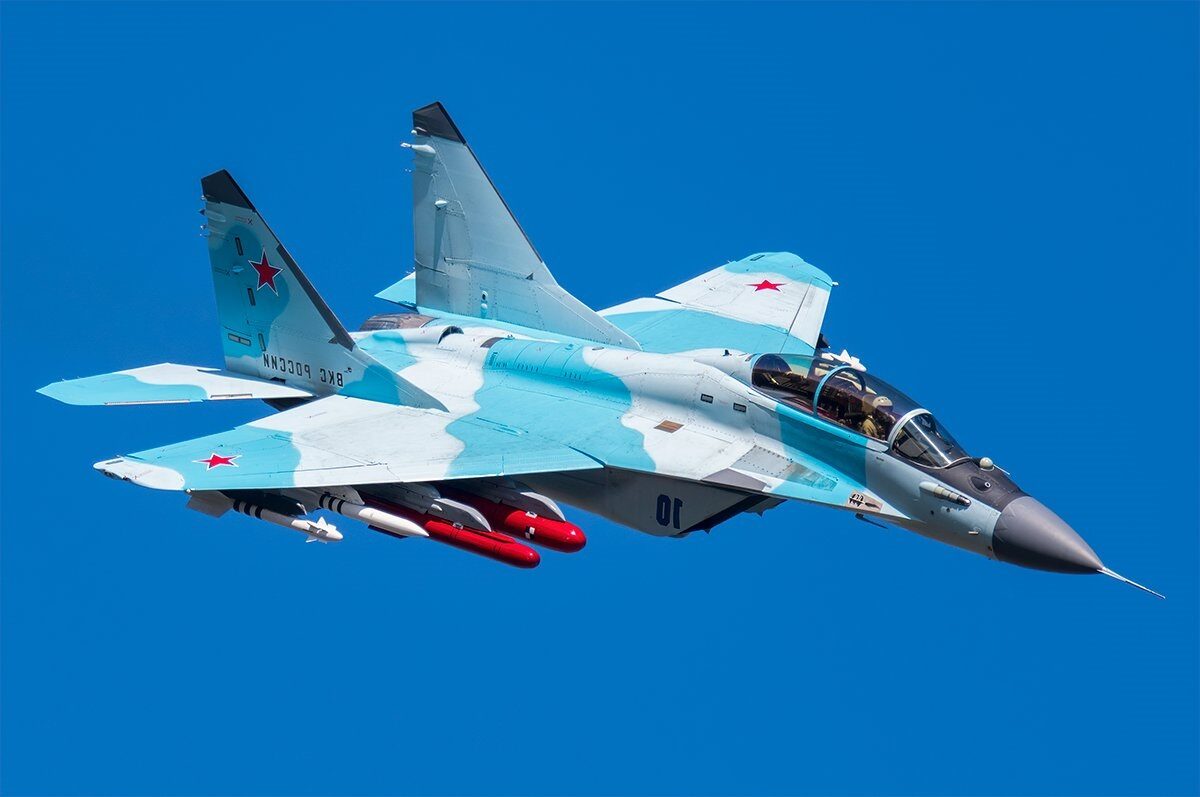
Image: https://www.19fortyfive.com/
Overview of the Mikoyan MiG-35
The Mikoyan MiG-35, developed by the renowned Russian aircraft manufacturer Mikoyan, is a state-of-the-art fighter jet showcasing aviation technology’s pinnacle. Designed as a successor to the MiG-29, this formidable aircraft combines advanced features and capabilities to dominate the skies. With its sleek design and cutting-edge systems, the MiG-35 represents a new era in aerial combat.
Key Features and Capabilities of the Mikoyan MiG-35, The Mikoyan MiG-35, stands out due to its impressive array of features and capabilities. Equipped with the latest avionics and weapons systems, it can perform various missions with exceptional precision and agility. Let’s explore some of its key features:
- Advanced Avionics: The MiG-35 incorporates state-of-the-art avionics, including an advanced radar system and a multifunctional glass cockpit. This gives the pilot unparalleled situational awareness and effective decision-making during intense aerial engagements.
- Enhanced Maneuverability: Thanks to its powerful engines and aerodynamic design, the MiG-35 boasts exceptional maneuverability. It can execute high-G maneuvers, making it highly effective in air-to-air and air-to-ground combat scenarios.
- Superior Stealth Technology: The MiG-35 utilizes advanced stealth technology, including radar-absorbent materials and reduced infrared and radar signatures. This allows it to operate covertly, minimizing the chances of detection by enemy radar systems.
- Versatile Weaponry: The MiG-35 is equipped with a wide range of weaponry, including air-to-air missiles, precision-guided bombs, and rockets. Its integrated weapon systems enable it to engage multiple targets simultaneously, ensuring superior combat effectiveness.
Performance and Combat Effectiveness of the Mikoyan MiG-35
The Mikoyan MiG-35’s exceptional performance and combat effectiveness make it a force to be reckoned with in the skies. Here are some key highlights:
- Speed and Range: With a top speed of Mach 2.25 and a combat radius of over 1,000 kilometers, the MiG-35 can swiftly traverse long distances and engage targets at high velocities. This enables it to cover vast areas of operation effectively.
- Advanced Sensors: The MiG-35 is equipped with an advanced radar system capable of simultaneously detecting and tracking multiple targets. This allows for effective surveillance and engagement of both air and ground targets.
- High Combat Efficiency: The MiG-35’s advanced weaponry and superior maneuverability ensure high combat efficiency. It can precisely engage enemy aircraft and ground targets, delivering devastating blows to adversaries.
- Operational Versatility: The MiG-35 can perform various missions, including air superiority, ground attack, and reconnaissance. Its versatility makes it an invaluable asset to any air force, capable of adapting to different operational requirements.
In conclusion, the Mikoyan MiG-35 represents a leap forward in fighter jet technology. With its advanced features, capabilities, and combat effectiveness, it is undoubtedly one of the most formidable aircraft in the world. Whether engaging enemy aircraft or striking ground targets, the MiG-35 stands ready to dominate the skies and ensure air superiority for its operators.
Boeing F/A-18E/F Super Hornet

Image: https://en.wikipedia.org/
Overview
The Boeing F/A-18E/F Super Hornet is a powerful and versatile fighter jet that has gained widespread recognition for its exceptional performance in combat operations. As an upgraded variant of the original F/A-18 Hornet, the Super Hornet boasts advanced features and capabilities that make it a force to be reckoned with on the battlefield.
Key Features and Capabilities
The Boeing F/A-18E/F Super Hornet has cutting-edge features and capabilities that enhance combat effectiveness. Let’s take a closer look at some of its key attributes:
- Improved Performance: The Super Hornet is powered by two General Electric F414-GE-400 engines, providing impressive speed, agility, and maneuverability. This allows the aircraft to excel in both air-to-air and air-to-ground missions.
- Versatile Weapon Systems: The Super Hornet can carry many weapons, including air-to-air missiles, air-to-surface missiles, precision-guided bombs, and even anti-ship missiles. This versatility enables the aircraft to effectively engage various targets precisely and accurately.
- Advanced Avionics and Sensors: Equipped with state-of-the-art avionics and sensor systems, the Super Hornet offers superior situational awareness to its pilots. This includes advanced radar systems, electronic warfare suites, and targeting pods, enabling the aircraft to detect and effectively engage in threats.
- Carrier-Based Operations: The Super Hornet is designed for carrier-based operations, making it well-suited for naval aviation. Its ability to take off and land on aircraft carriers allows for increased flexibility in deployment and strategic capabilities.
Performance and Combat Effectiveness
Regarding performance and combat effectiveness, the Boeing F/A-18E/F Super Hornet truly stands out. Here are some remarkable aspects of its capabilities:
- Speed and Range: With a top speed of Mach 1.8 and a combat radius of approximately 390 nautical miles, the Super Hornet can swiftly cover vast distances and engage targets over a wide area of operations.
- Air Superiority: The Super Hornet’s exceptional maneuverability and advanced weapon systems allow it to gain air superiority in combat scenarios. Its ability to engage enemy aircraft with air-to-air missiles and its built-in 20mm M61 Vulcan cannon make it a formidable opponent in aerial combat.
- Precision Strikes: The Super Hornet can deliver highly accurate strikes against ground targets thanks to its advanced targeting systems and precision-guided munitions. The aircraft’s capabilities ensure successful mission outcomes, whether it’s engaging enemy vehicles, structures, or even naval vessels.
- Electronic Warfare Capabilities: The Super Hornet’s electronic warfare suites are crucial in disrupting and neutralizing enemy radar and communication systems. This capability enhances the aircraft’s survivability and combat effectiveness in hostile environments.
In conclusion, the Boeing F/A-18E/F Super Hornet’s comprehensive features, advanced capabilities, and impressive combat performance make it one of the world’s strongest and most formidable fighter jets. Its versatility, speed, and precision make it an essential asset in modern warfare, enabling it to excel in various mission types.
Saab JAS 39 Gripen

Image: https://www.bundeswehr.de/
The Saab JAS 39 Gripen is a remarkable fighter jet that has gained recognition for its exceptional performance and advanced capabilities. As an aviation enthusiast, I am excited to explore this impressive aircraft’s key features, abilities, and combat effectiveness.
Overview of the Saab JAS 39 Gripen
The Saab JAS 39 Gripen, developed by the Swedish aerospace company Saab, is a multi-role fighter aircraft designed to excel in various mission scenarios. Renowned for its agility, versatility, and advanced technology, the Gripen has become a prominent player in the global defense industry.
Key Features and Capabilities of the Saab JAS 39 Gripen
- Agility: The Gripen’s aerodynamic design and powerful engines allow it to maneuver swiftly and effortlessly, enabling it to outmaneuver adversaries in air-to-air and air-to-ground combat.
- Avionics: Equipped with state-of-the-art avionics, including advanced radar systems and sensor fusion technology, the Gripen provides pilots unparalleled situational awareness, enhancing their tactical decision-making capabilities.
- Weapon Systems: The Gripen is armed with a wide range of air-to-air and air-to-ground weaponry, enabling it to engage targets with precision and versatility. An integrated electronic warfare system can effectively counter threats and protect itself and allied forces.
- Net-Centric Warfare: Gripen’s ability to seamlessly integrate into network-centric warfare systems allows for real-time communication and information sharing with other aircraft and ground-based units, enhancing overall mission effectiveness.
Performance and Combat Effectiveness of the Saab JAS 39 Gripen
- Speed and Range: The Gripen possesses an impressive top speed of Mach 2, enabling it to rapidly respond to threats and conduct operations beyond enemy lines. Its extended range allows for extended patrol durations and the ability to cover vast distances.
- Short Takeoff and Landing (STOL): Gripen’s STOL capabilities enable it to operate effectively from shorter runways, making it more flexible and adaptable in various operational environments.
- Advanced Electronic Warfare Systems: Gripen’s advanced electronic warfare capabilities, including electronic countermeasures and jamming systems, provide a significant advantage by disrupting enemy radar and communication systems.
- Operational Versatility: With its ability to seamlessly transition between air-to-air and air-to-ground operations, the Gripen can fulfill a wide range of mission requirements, making it an ideal choice for national defense and international coalition operations.
In conclusion, the Saab JAS 39 Gripen is one of the world’s strongest fighter jets, combining agility, advanced technology, and combat effectiveness into a formidable aircraft. Its impressive features, capabilities, and performance make it a crucial asset in maintaining air superiority and safeguarding national security. Whether engaging in air combat or conducting precision strikes, the Gripen proves its worth as a versatile and powerful fighter jet.
Lockheed Martin F-16 Fighting Falcon
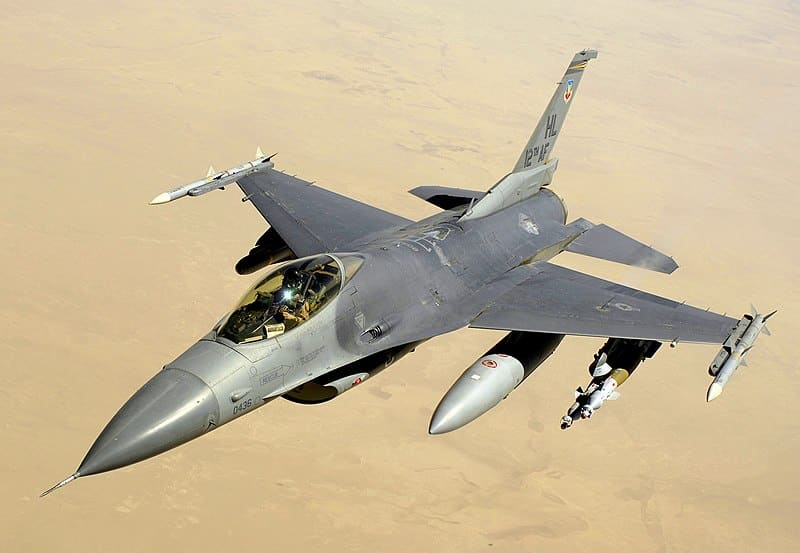
Image: wikipedia
The Lockheed Martin F-16 Fighting Falcon is a highly versatile and powerful fighter jet that has established itself as a dominant force in the skies. With its exceptional maneuverability, advanced weaponry, and cutting-edge technology, the F-16 has become a true icon of aerial combat. This section will delve into the overview, key features, and capabilities, as well as the performance and combat effectiveness of the Lockheed Martin F-16 Fighting Falcon.
Overview of the Lockheed Martin F-16 Fighting Falcon
The Lockheed Martin F-16 Fighting Falcon, often called the “Viper,” is a single-engine, multi-role fighter aircraft. It was first introduced in the 1970s and has since undergone numerous upgrades to maintain its superiority in the ever-evolving battlefield. The F-16 is renowned for its compact design, which maximizes both speed and agility while minimizing its radar signature.
Key Features and Capabilities of the Lockheed Martin F-16 Fighting Falcon
The F-16 boasts an impressive array of features and capabilities, making it a formidable force in aerial combat. Here are some key highlights:
- Maneuverability: The F-16’s exceptional maneuverability allows it to outperform many other fighter jets in dogfights. Its fly-by-wire flight controls and high thrust-to-weight ratio enable quick and precise maneuvers, giving it a significant advantage in air-to-air engagements.
- Advanced Avionics: Equipped with state-of-the-art avionics systems, the F-16 offers enhanced situational awareness to its pilots. Its modern cockpit display provides vital information in real-time, allowing pilots to make informed decisions swiftly.
- Weapon Systems: The F-16 can carry a wide range of weaponry, including air-to-air missiles, air-to-ground missiles, precision-guided munitions, and bombs. This flexibility enables the aircraft to engage both aerial and ground targets effectively.
- Supersonic Speed: Capable of reaching speeds exceeding Mach 2, F-16 possesses exceptional acceleration and top speed. This enables it to rapidly respond to threats and cover large distances in a short amount of time.
- Air Superiority and Suppression of Enemy Air Defenses (SEAD): The F-16’s advanced radar and electronic warfare systems allow it to gain and maintain air superiority. Additionally, it can effectively suppress enemy air defenses, neutralizing threats to other friendly aircraft.
Performance and Combat Effectiveness of the Lockheed Martin F-16 Fighting Falcon
The performance and combat effectiveness of the Lockheed Martin F-16 Fighting Falcon is unparalleled. Here’s why:
- Combat Range: The F-16 has an impressive combat radius, allowing it to operate at extended distances from its base of operations. This range ensures the aircraft can effectively cover vast territories and engage targets deep within enemy territory.
- Versatility: The F-16’s multi-role capabilities make it highly versatile in various mission scenarios. Whether in air-to-air combat, close air support, interdiction, or reconnaissance, the F-16 can adapt to different roles seamlessly.
- Reliability: The F-16 has proven to be a reliable and durable aircraft, capable of withstanding demanding operational conditions. Its robust design and maintenance programs ensure maximum availability for missions.
- Training and Interoperability: The F-16’s widespread use among different countries and its interoperability with allied forces provide significant advantages. Pilots benefit from standardized training programs, sharing tactics, and fostering efficient cooperation during joint operations.
In conclusion, the Lockheed Martin F-16 Fighting Falcon is a highly advanced and capable fighter jet. Its exceptional maneuverability, advanced avionics, versatile weapon systems, and impressive performance make it a dominant force in the skies. Whether engaging enemy aircraft or striking ground targets, the F-16 continues to prove its combat effectiveness, solidifying its position as one of the world’s strongest fighter jets.
Note: This section overviews the Lockheed Martin F-16 Fighting Falcon and highlights its key features, capabilities, performance, and combat effectiveness. Additional sections will cover other fighter jets in the same manner.
Conclusion
In conclusion, aviation has witnessed the development of some truly remarkable fighter jets. These powerful machines showcase the cutting-edge technology and engineering prowess of nations across the globe. Each aircraft on this list has unique strengths and capabilities, from the F-22 Raptor to the Sukhoi Su-35.
When evaluating the strength of a fighter jet, several factors come into play, including speed, maneuverability, weaponry, and stealth capabilities. As discussed in this blog post, the top 10 strongest fighter jets in the world have excelled in these areas, making them formidable assets for their respective countries’ air forces.
Related Articles
10 Best Handguns for Self-Defense
When it comes to...
The Truth About Sanctions: Why Don’t They “Work”?
In 2022,...
History of Israel-Palestine Conflict
Israel and...
After the WAR initiated by HAMAS on October 7th, the Middle East will not be the same
On the -th of...
The Israeli army is prepared for an offensive on the Gaza Strip, involving attacks from “air, sea, and land.”
The IDF (Israel...
War in Israel: Current Developments – Video
Rafah...
Russia vs USA: Who Would Win in a Potential War?
In the...
NATO vs China: Who Would Win in a Potential War?
In the realm of...
11 Best Assault Rifles in the World
Welcome to a world...
Yevgeny Prigozhin (Wagner founder) is dead
According...
What You Need to Know About Joining NATO
Has any country...
Terrifying Realities of a Potential Nuclear War
The Devastating...
What to Do in Case of a Nuclear Attack
What to Do in Case...
11 Strongest and Most Powerful Navies in the World
When it comes to...
The Most Powerful Nuclear Weapons
The sheer power...
Understanding the Nature of War – The Clash of Wills
War is the...
Ukrainian Defense Forces Celebrate One-Year Anniversary of Kherson Region Liberation
Around one year...
Prigozhin First Video Speech After Unsuccessful Uprising
Following a recent...
11 Best Sniper Rifles in the World
Important Factors...
What is Russia saying about the war in Ukraine, Episode 1
Did you ever...
13 Most Powerful Weapons in the World
Weapons of immense...
What is Happening in Russia, Episode 3
Welcome to the...
What is Happening in Russia, Episode 2
Have you ever...
10 Strongest Tanks in the World
Tanks represent...
10 Strongest Armies in the World
When it comes to...
Putin: We cannot stop the fire when they advance on us!
Putin ten...
10 Best Air Defence Systems in the World
Image:...
Alexei Navalny Letters From Prison
Image:...
Ukraine’s Struggle for Survival and Western Dependency
Ukraine has long...
What is Happening in Russia, Episode 1
Have you ever...
10 Strongest NATO Members
Image:...
Mobilized Soldiers Expose Dire Conditions and Neglect in Deployment to Luhansk
source:...
Why is everything so poor and sad in Russia?
Image:...
Tensions Escalate in Northern Kosovo as Serbian President Mobilizes Army
Image:...
Putin’s Russia and the Need for a Fresh Security Approach in Europe
Image:...
DeSantis Declares Presidential Bid with Elon Musk
Image:...
Russian military personnel shelled the Zaporizhia Nuclear Power Plant
Image:...
Prigozhin Revelations The Truth Behind the Capture of Bakhmut
Image:...
President Zelensky Visit G7 Turning Point in Russia-Ukraine War
Image:...
Turning a Blind Eye No More: Zelensky’s Bold Stand Against Crimean Annexation
Unfortunately,...
Navigating the Fluidity of War and Geography: Insights and Strategies
War is Geography:...
Latest Updates on Russian Invaders’ Activities in Occupied Territories
Russian Invaders...
US Denies Ukrainian Pilots Training on F-16 Fighter Jets
Complexities of...
West Strong Support for Ukraine’s Recovery and Containment of Russia
Kremlin's Failed...
Ukraine Supreme Court Chairman Confronts Allegations of Blatant Bribery
Vsevolod Knyazev...
Gold Coin Treasure from Alexander the Great Era found in Annexed Crimea
Crimea's Hidden...
Rishi Sunak Hails Zelenskyy as a Modern-Day Churchill
Volodymyr...
The Moral Factor in War: Ukraine’s Key to Victory
"We were actively...
The West’s Triumph in the New Cold War: Technology of Freedom Wins Out
The Chinese leader...
The Illusion of Power: How Putin’s Russia is Making the Same Mistakes as its Past Leaders
Modern Russia and...



